Art Fairs
The 5 Best Works at FIAC, From a Show-Stopping Installation by Thomas Bayrle to Fashion Legend Martin Margiela’s Art World Debut
Here are some standout pieces from this year’s fair in Paris.
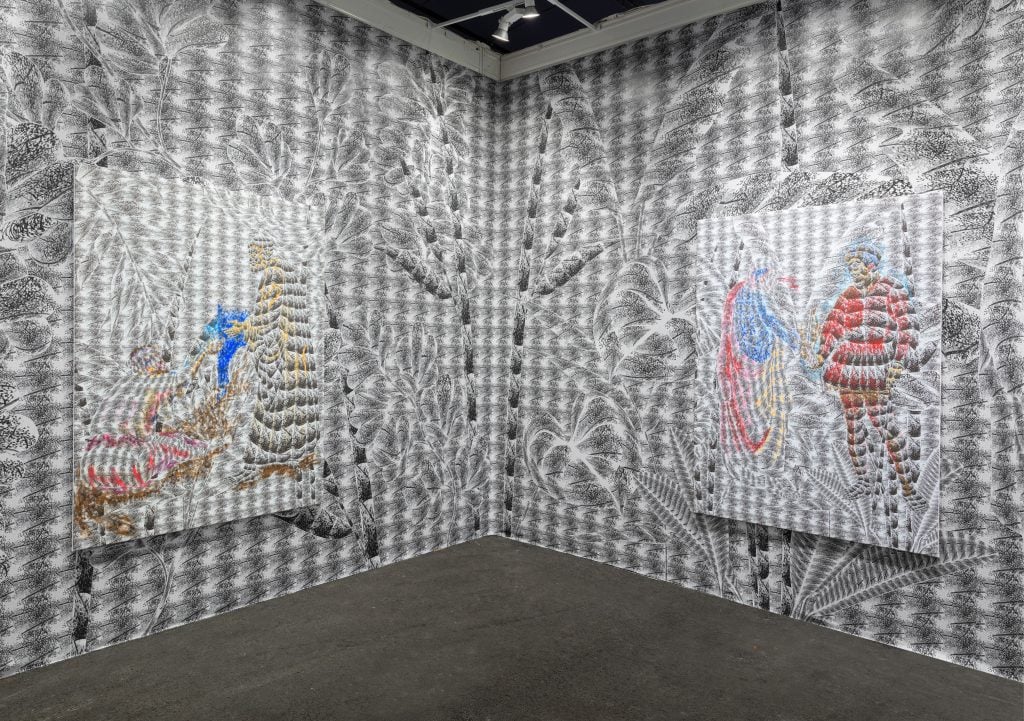
Here are some standout pieces from this year’s fair in Paris.

Devorah Lauter

Just a few years ago, it would have been hard to imagine such enthusiasm to shop at a large Paris art fair, but that has been the vibe this year in the jam-packed aisles at FIAC, despite stifling humidity at the show’s temporary venue near the Eiffel Tower.
“How are you enjoying the Covid bath?” asked one VIP cheekily, while seriously lamenting the lack of fresh air in the crowded building on opening day. FIAC doesn’t have the outdoor café (with a view of the Eiffel Tower) that Art Paris fair offered visitors earlier this September, so guests resorted to sitting on the ground wherever they could find a patch of wall to lean on thanks to a draconian budgeting of chairs at the few cafés around the fair. At the smaller-scale Paris Internationale across the Seine, located in a 19th-century Parisian building, there was less of a frenzy to wade through, and the works of young or emerging artists there could be comfortably taken in while enjoying wallpapered rooms and stained-glass windows.
Nevertheless, after over a year without in-person contact, crowds at FIAC were not deterred and neither was Artnet News. There is no shortage of arresting works to enjoy in-person before they head off to new homes.
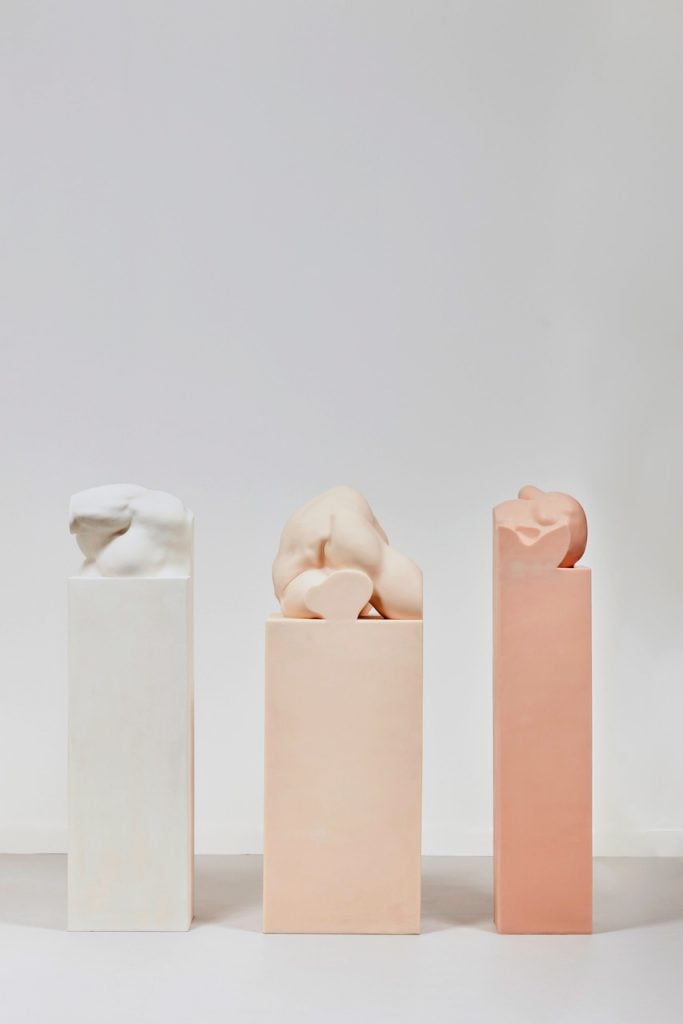
Martin Margiela, Torso I, II, III (2018-2021). Photo: Studio Shapiro.
Martin Margiela’s three skin-toned “torso” sculptures are easily this season’s must-see works at the fair, causing a buzz at Zeno X booth. Just a few weeks ago, the Antwerp gallery began representing the artist, who quit fashion design in 2009. Now, Margiela is making his debut in the art world with a highly anticipated exhibition at Lafayette Anticipations in Paris.
Hype aside (including an interested Brad Pitt who also stopped by the booth), the works themselves—enigmatically twisted masculine forms bisected and placed atop plinths—are a strange and satisfyingly sensual commentary on bodily forms, skin, and ideal beauty. The creamy-textured sculptures are more mutant than human. The artist also invites the public to touch the work, reconciling experience and representation.
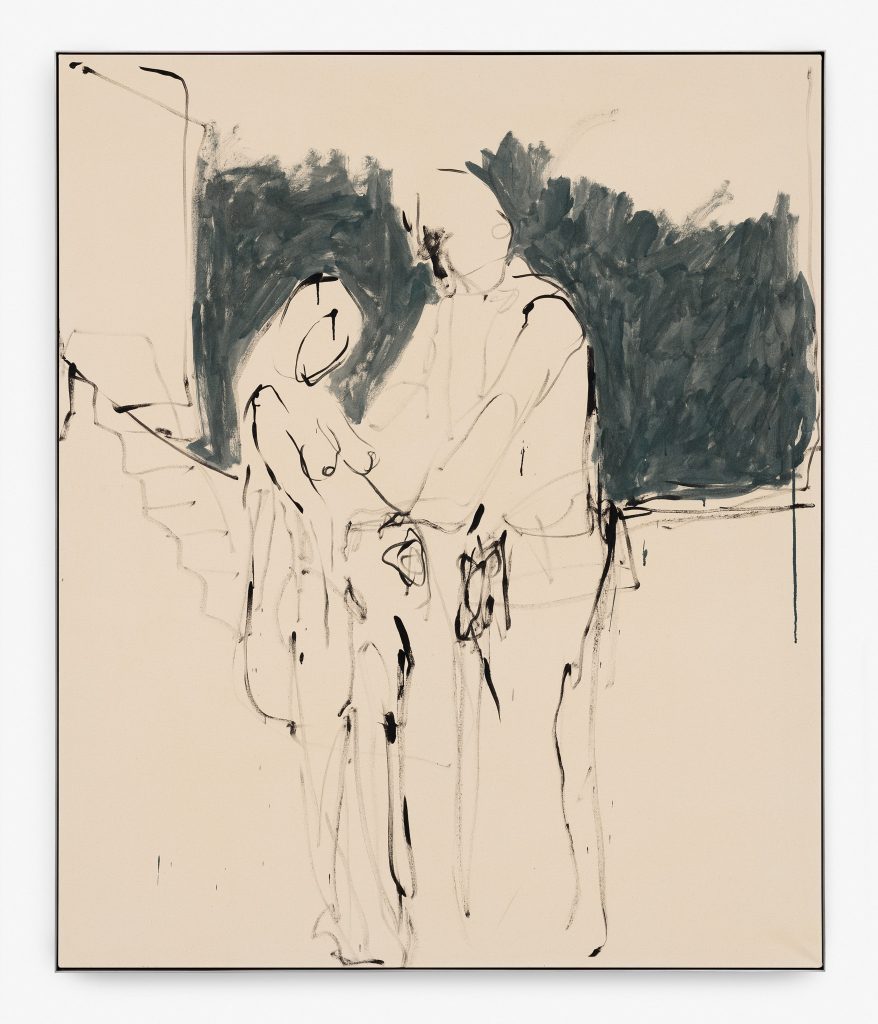
Tracey Emin I Wanted To Feel Safe With You (2019). Courtesy: the Artist and Xavier Hufkens, Brussels. Photo credit: HV-studio, Brussels
If you have a chance to see a Tracey Emin painting in-person, you best take it. Her gestural works come alive. Such an experience is available at Xavier Hufkens’s booth at FIAC, where a large painting called I Wanted To Feel Safe With You from 2019 is on view. It was made in the time before Emin was diagnosed with bladder cancer, which caused her to take a long break from making art. She has more recently been cleared of cancer but is still battling with the aftermath, and only recently returned to the studio.
In the piece on view at the fair, a pregnant woman and a man face each other, both appearing to gaze downward at her full belly—a prime example of Emin’s ability to create works that candidly glean from her inner world, including personal memories and trauma.
Despite the tribulations of the last years, Emin has a major exhibition opening today, October 23, at the new Munch Museum in Oslo alongside Edvard Munch, who heavily influenced her practice. She has also been invited to install a large bronze sculpture called The Mother on Olso’s Museum Island close to the Munch Museum in June 2022, telling reporters that “Munch’s mother died when he was very young, so I want to give him a mother.”
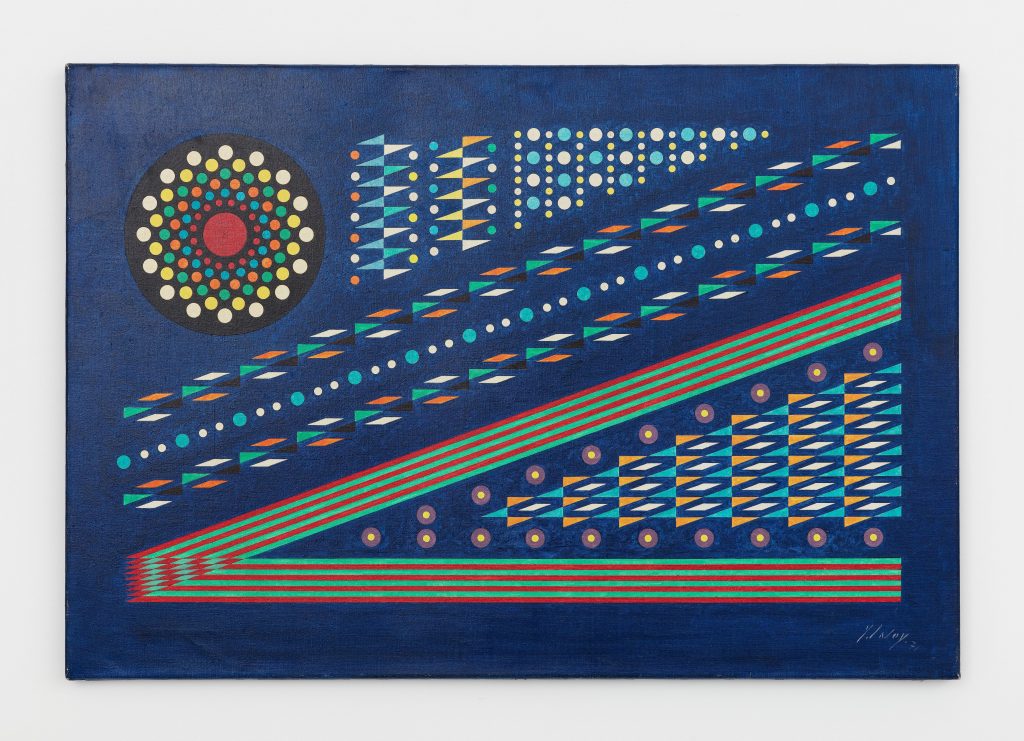
Yves Laloy’s Sans titre (1971). © Photo: Claire Dorn/Courtesy of the artist and Perrotin
French painter Yves Laloy, who died in 1999, was much admired by surrealist thinker André Breton, but his work has largely been ignored by major institutions outside his hometown of Rennes. Laloy’s swashbuckling life story and works are being given an overdue moment in the limelight thanks to Perrotin, which is planning a large exhibition set for January 2022 at the gallery’s location in the Marais in Paris.
Laloy was trained as an architect but turned to art after famously insulting the local prefect in Rennes, which led him to flee the country and cross North Africa by bicycle in the 1950s. He ended up imprisoned in Egypt on charges of espionage, but eventually became a sailor who famously scoffed: “Staying on land—never!”
Inspired by Navajo Indigenous art and culture, his colorful tableaux depict otherworldly creatures and delicately balanced geometric forms reminiscent of surrealism, though the artist insisted he was guided by spirituality and did not affiliate with with the surrealist movement. It is surprising considering that his painting donned the cover of Breton’s 1965 manifesto, Surrealism and Painting, and his inclusion in several surrealist gallery exhibitions in Paris in the mid 20th-century.
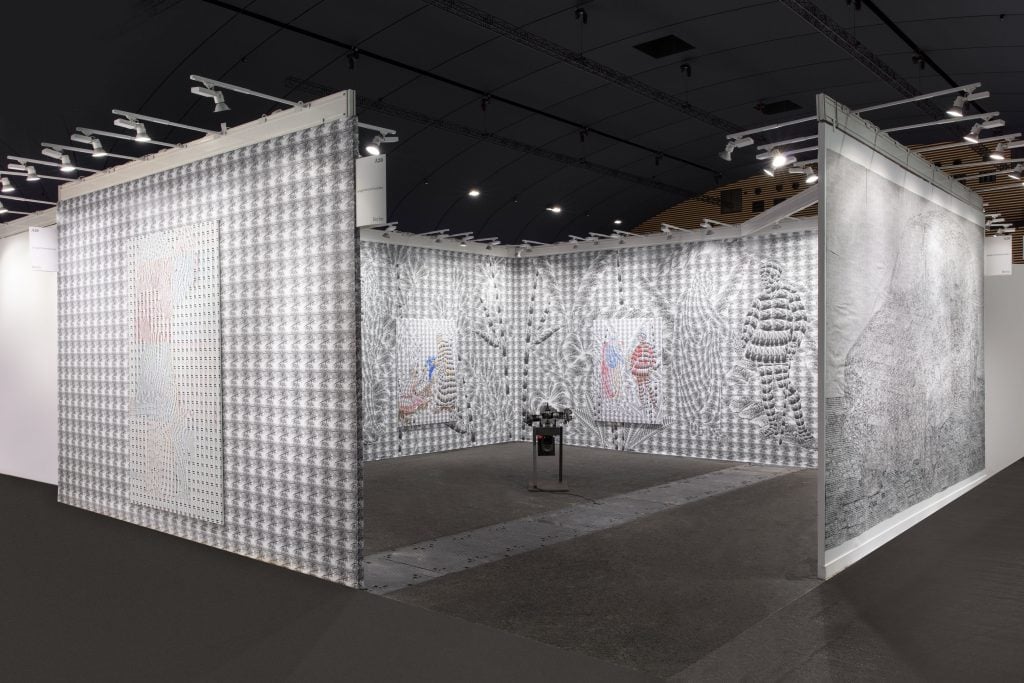
Installation view: Thomas Bayrle, neugerriemschneider, Berlin, FIAC, 2021 © Thomas Bayrle. Courtesy the artist and neugerriemschneider, Berlin. Photo: Sebastiano Pellion di Persano
Wowing visitors upon entering the FIAC, it is hard not to miss Thomas Bayrle’s immersive Brancacci Chapel, which was created especially for the fair. The acclaimed German Pop artist presents new and historical multimedia artworks in a mesmerizing wallpaper installation that is adorned with canvas pieces inspired by 15th-century art and early Renaissance frescoes.
Using his long-held interest in ritualized, repetitive forms, motion, and sound, Bayrle depicts Biblical narratives, which come into focus the more one gazes at the installation. They dialogue with printed motifs based on the artist’s “superform” method of repeating everyday imagery to create an overall image. Here, he used drawings of crushed grapes on the road and their negative shadows become a recurring pattern. Throughout, the sound of a humming car engine can be heard above Edith Piaf’s low crooning voice that emanates from a kinetic sculpture at the center of the chapel. Taken in all together, Bayrle pulls the viewer into the past while holding them in a strange present. Moving through the installation, we are suspended in limbo between time and space.
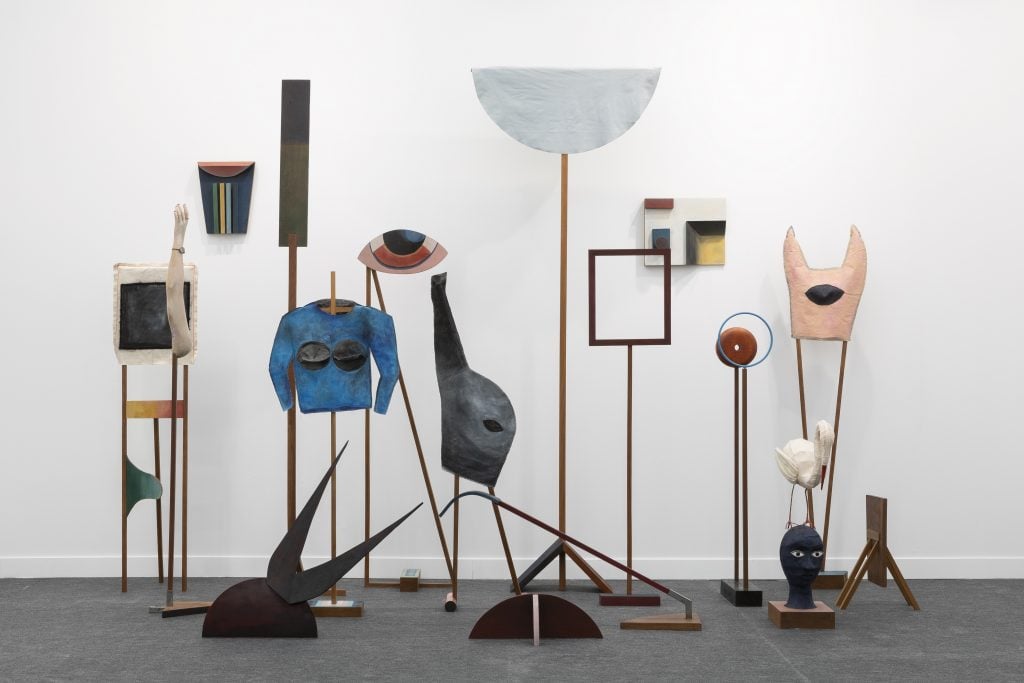
Ana Mazzei, Drama O’Rama (2021). Courtesy: Galeria Jaqueline Martins/photo: Emilie Mathé Nicolas
Brazilian artist Ana Mazzei, born in 1980, is deservedly attracting attention at FIAC where her theatrical installation of dream-like sculptures, Drama O’Rama, take their bow. Created while the artist was first stuck in lockdown in Scotland and then in Brazil, Mazzei made each painted mixed media sculpture separately. Mostly propped on puppet-like stilts, she finally brought them all together like a gang of actors in an absurdist performance at the Galeria Jaqueline Martins’s booth.
Her work, which is part of institutional collections such as Nouveau Musée, Monaco, the Sammlung Philara Collection in Dussseldorf, and the Centre National des Arts Plastique in Paris, among others, drawing on her own lexicon of symbols. She then narrates a fictional construction that combines art, architecture and landscape that is specific to each site.